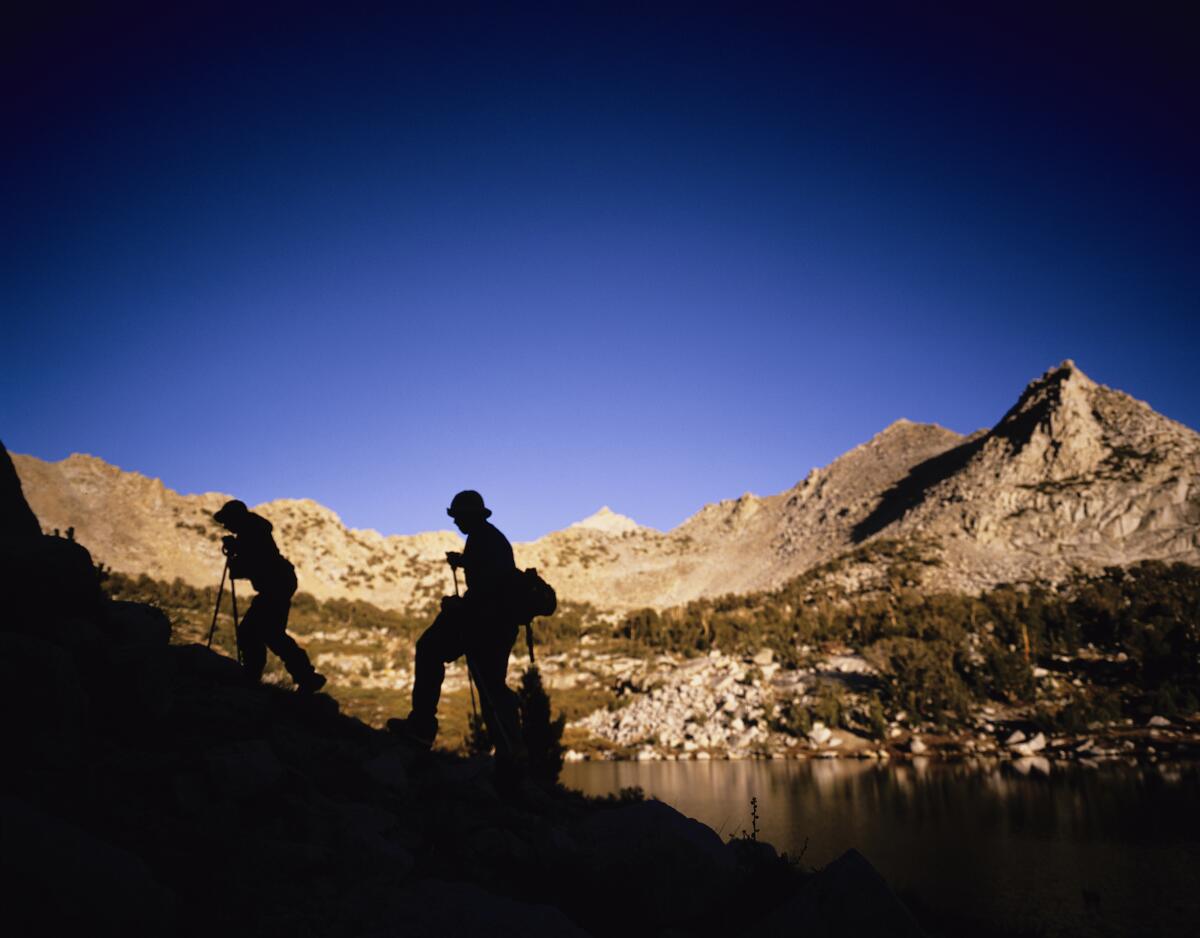I’m 17 and grew up hiking the Sierra. I’m hopeful it can survive effects of climate change

- Share via
As a 17-year-old born and raised in the Central Valley, I grew up with the Sierra Nevada as my second home — backpacking through sequoia groves, drinking alpine water and gazing at cobwebs of stars.
But over the past year, wildfires, a viral pandemic and college applications have limited my outdoor excursions. When I returned to my old home for a backpacking trip, I was shocked at the stark difference between the current reality and my idyllic memories. Even in just a decade, I’ve watched the Sierra wilt under the brute force of climate change, the sanctuary of my youth burning to ashes. How will it endure two more decades? Or four?
In July, my family drove to Kings Canyon National Park to backpack the Rae Lakes Loop, a 41.4-mile trail chock full of silky lakes and crumbling mountain passes. It was the first time we’d been in the mountains since the devastating Creek fire a year and a half ago, and years since our first glimpse of Kings Canyon.
An odd sense of emptiness hovered about our car as we slithered up Highway 180. The forest that once repressed sharp rays of sun had given away to stretches of black ash. The remaining pines, once capable of surviving subzero winters on 80-degree granite slopes, were reduced to blackened toothpicks. Even the immense granite faces and magnificent jagged cliffs of Kings Canyon were yellowed and left barren by the intense heat and wildfires of the past months.
I had known the Sierra to be unforgiving in its beauty and unpredictability. Having always been in awe of nature’s terrifying power, I was pained to see the Sierra vulnerable, brought to its knees by human-induced climate change.
Though drought, heat waves and wildfires are all natural phenomena, climate change increases the frequency and severity of all three. They are also mutually reinforcing. As places like Kings Canyon heat up, drought becomes increasingly common. Snowpack levels drop, and clouds dissipate before releasing rain. Plants, animals, backpackers and farmers alike thirst for water from shallow, trickling streams. Trees and other plant life die of water loss and insect epidemics, fueling the severity and duration of wildfires.
The signs of climate change are all around us, yet we’ve staved off the consequences of our actions by sheltering in our air-conditioned homes and watching pretty documentaries, believing that Earth’s resources remain pure and unmarked by human touch. But what happens when we can’t protect even the most hallowed lands from our actions? Even during my pandemic hiatus from the wilderness, the power was shifting between humans and the environment. Nature isn’t invincible; it never was.
That week, I found devastation in the scarred trees and dried creeks of the Rae Lakes Loop. But I also found hope.
Along the trail, I let my hands run across the freshly sprung grass near the riverbed and prayed for the many young saplings pushing through the fertile, black ash. Deer, large and small, roamed the forests and gulped water from the rocky beds of the Kings River. They served as a reminder of nature’s resiliency, that even the deepest, most sacred folds of the mountains are capable of fighting humanity’s reaching impact.
Thankfully, Generation Z — my generation — is anything but silent on the issue of climate change. After all, our future lives depend on new policies and cultural attitudes that will both preserve our natural world and ensure a safe and sustainable life for us and the generations after. The Intergovernmental Panel on Climate Change’s most recent report warns that we’re in “code red”; our summers are only getting hotter, smokier and longer. It’s only a matter of time before we’re forced to confront the cataclysmic fallout of a warming planet.
I’m a senior in high school, and I’ve already backpacked hundreds of miles in the Sierra and summited its tallest, 14,000-foot peaks. Still, there’s so much more that I want to share with my friends and family. I want them to feel the same terrifying awe of nature, to fall deeply in love with it, as I had so long ago.
Of course, the state of the planet frightens me. But when I see the blades of grass and saplings of the Sierra, I still feel hopeful. I believe, if we show enough passion and respect for each juniper pine and robin, that nature can still be saved from humankind. We just need people to care.
Juliet Fang is a high school senior in Fresno. She is a research assistant at the UC Davis Western Center of Health and Agricultural Safety and at the Central Valley Health Policy Institute.
More to Read
A cure for the common opinion
Get thought-provoking perspectives with our weekly newsletter.
You may occasionally receive promotional content from the Los Angeles Times.









